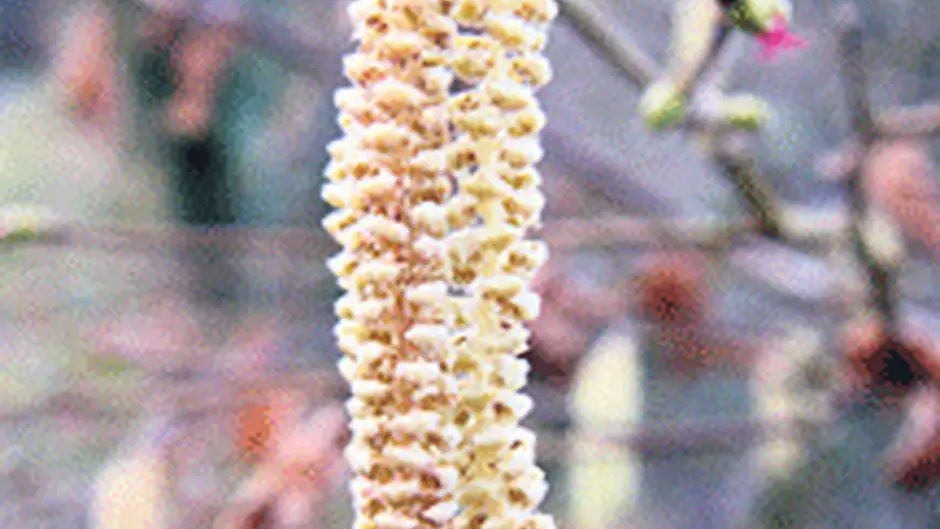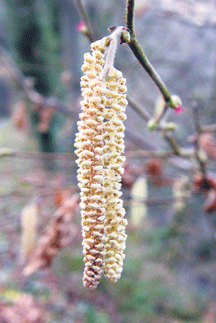Pollen studies have revealed that the hazel tree was present on the ancient landscape of West Cork
Wildlife with an amateur observer
One of the few disadvantages to living by the sea is the difficulty in getting anything to grow in the garden. The salt-laden wind whips most plants into submission and I have a hedge that has barely grown two feet in five years. There are some resilient exceptions though, and one of them is the hardy hazel. At this time of the year, hazel bushes are adorned with dancing catkins. These ‘lambs’ tails’ are a glorious reminder that spring is here whatever the weather.
Ancient Species
Studies have shown that hazel was one of the early colonisers of this island. Pollen analysis studies involve boring a hole into a bog or lake and extracting a core. This core contains fossilised pollen which can be used to identify species. Here in West Cork, we are fortunate that such a study was carried out in Lough Hyne and so we have a local picture of the ancient floral landscape of West Cork.
Alongside the pollen analysis, a study called dendrochronology is used. This extraordinary science analyses tree rings to calibrate radiocarbon dates, giving us a more precise picture of what happened and when.
By using these tools scientists can tell us that hazel, alder, willow and birch were the first wind-pollinated plants to evolve here. In fact, hazel was most likely growing in West Cork before there was a human presence here. But archaeologists may yet find earlier evidence of the arrival of man.
Hazel for wisdom
In myth and folklore, the hazel is a symbol of fertility, wisdom, kingship and mystical knowledge. It was also believed that it offered protection against evil and carrying a rod of hazel at night was thought to be a good defence against evil spirits. Similarly, a piece of hazel tied to a horse prevented the fairies from abducting it.
Hazel is noted for growing near water and hazel twigs are often used by diviners or dowsers to seek water. Folklore also says that hazel protects against snakes. Many emigrants from Ireland had a stick of hazel in their pack when going to the US or Australia to save them from the snakes there.
The Gaelic hero Fionn Mac Cumhaill acquired his power of wisdom after eating a ‘salmon of knowledge’ which had been fed on hazel nuts. This association with knowledge links the hazel with kingship too and the Irish word for hazel, ‘coll’, can be interpreted as chieftain.
Many of the sacred solitary trees – the bile – were hazel. The mythological tribe, the Tuatha Dé Danann, put three things above all else – the plough, the sun and the hazel tree. The hazel represented the priests and kingship and their special abilities.
This respect for the humble hazel led to its designation as a ‘noble of the wood’ in old Irish law. This was the highest level in the hierarchy of trees. Under these laws, there were fines for damaging a neighbour’s tree or bush and these varied according to its place in the hierarchy. For cutting a branch of a ‘noble’ the fine was one ‘dairt’ (year-old heifer); for cutting a fork of a noble, this went up to one ‘colpthach’ (two-year-old heifer) and for base felling the fine went to one milch cow. For removing a ‘noble’ altogether, the fine was the value of two and a half milch cows. Try imposing that fine today for the removal of a hazel tree!
Coppicing
In the wild, hazel grows as a small tree or forms bushy thickets in the shade of woods or hedgerows. Utilised extensively by man for millennia, it is very easy to coppice. This ancient practice of wood management is still ecologically sound. It involves cutting down hazel, and other broadleaved woodland trees, at regular intervals – anything from 5 to 25 years, depending on the species. By doing this, a cluster of new shoots sprout up from the stumps and grow into straight poles suitable for stakes, fencing and weaving. This was an extensive practice in the past and woods that were so managed were aptly named ‘coppices’. Nowadays the practice is being revived in recognition of its value to wildlife.
Hazel has been used by man since the late Stone Age when it was weaved to create wattle in building. It was also used as fencing material: split green hazel poles were woven into hurdles to fence in cattle and sheep. Nowadays gardeners still use it to create bean and pea poles and for small stakes.
Catkins
Hazel trees are most noticeable around now when they are sporting the creamy yellow male catkins. The yellow dangling catkins are the male of the tree; the female catkins are small and brown with bright crimson styles.
All catkin-bearing plants are wind-pollinated so it’s potentially easy to self pollinate by mistake. To get around this problem, the female hazel catkins don’t become receptive until the males of that particular tree have released all their pollen. Therefore at least two hazel trees must grow close together to ensure cross-pollination and the formation of nuts.
Catkins are a very effective way of spreading pollen. Each male catkin has over 100 tiny flowers and, because they are hanging, the wind sways them and causes the pollen to dissipate further. It takes about 6 years for a hazel tree to produce a good crop of nuts.
Birds, especially pigeons and pheasants, and small mammals, such as squirrels and mice, take the nuts for food and bury them. In this way, the trees become dispersed. However, because it cannot fertilise itself, it must rely on chance that a second hazel will emerge nearby.
There is a good spread of hazel in my garden and, unlike the hawthorn, it is doing really well. As it’s not really present anywhere else in the townland, I’m hoping that my little copse will help it to spread. It’s great to introduce a native hardy species to somewhere it’s not present. However, it’s probably not here for a good reason so hopefully it’ll survive.








